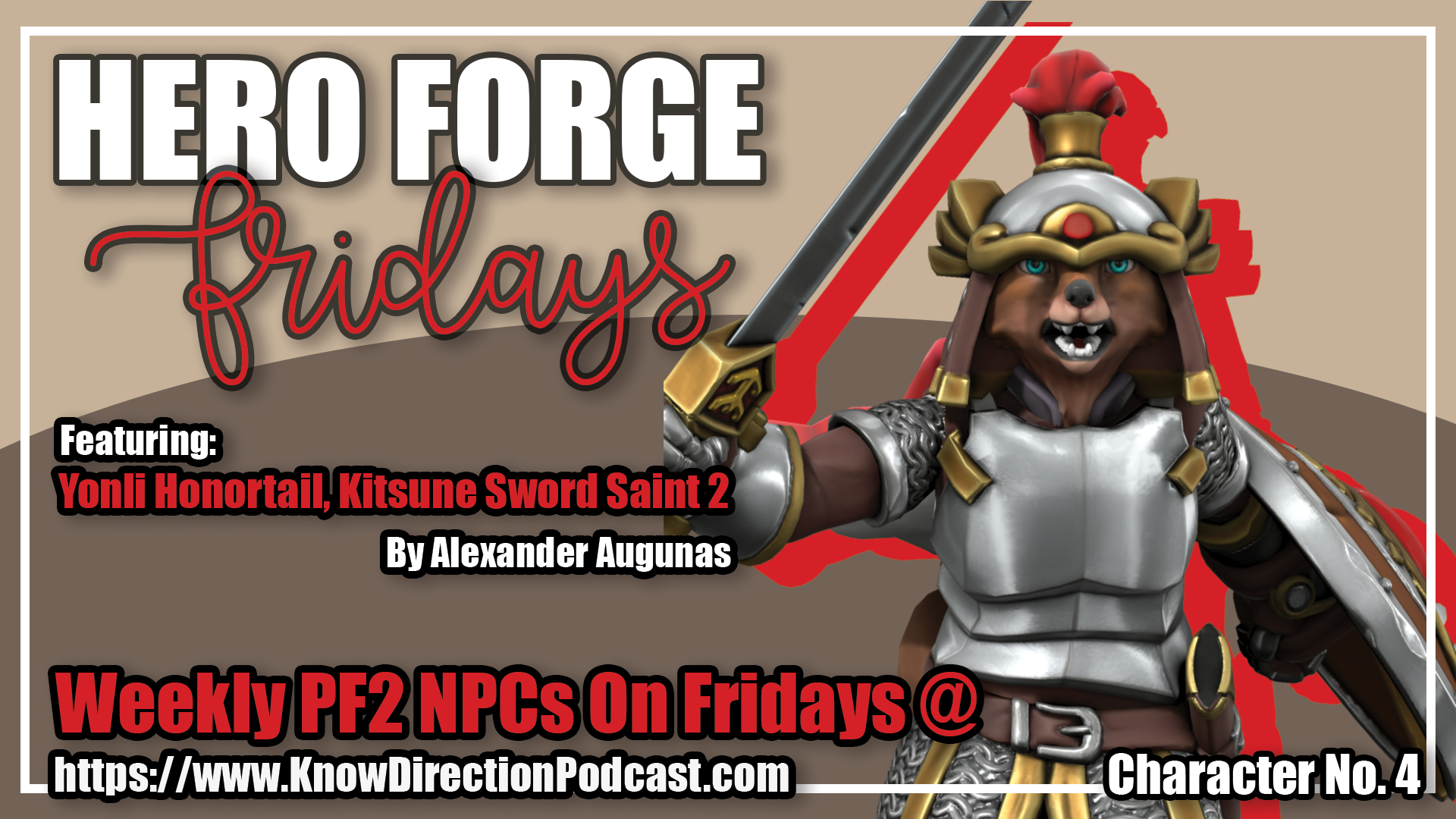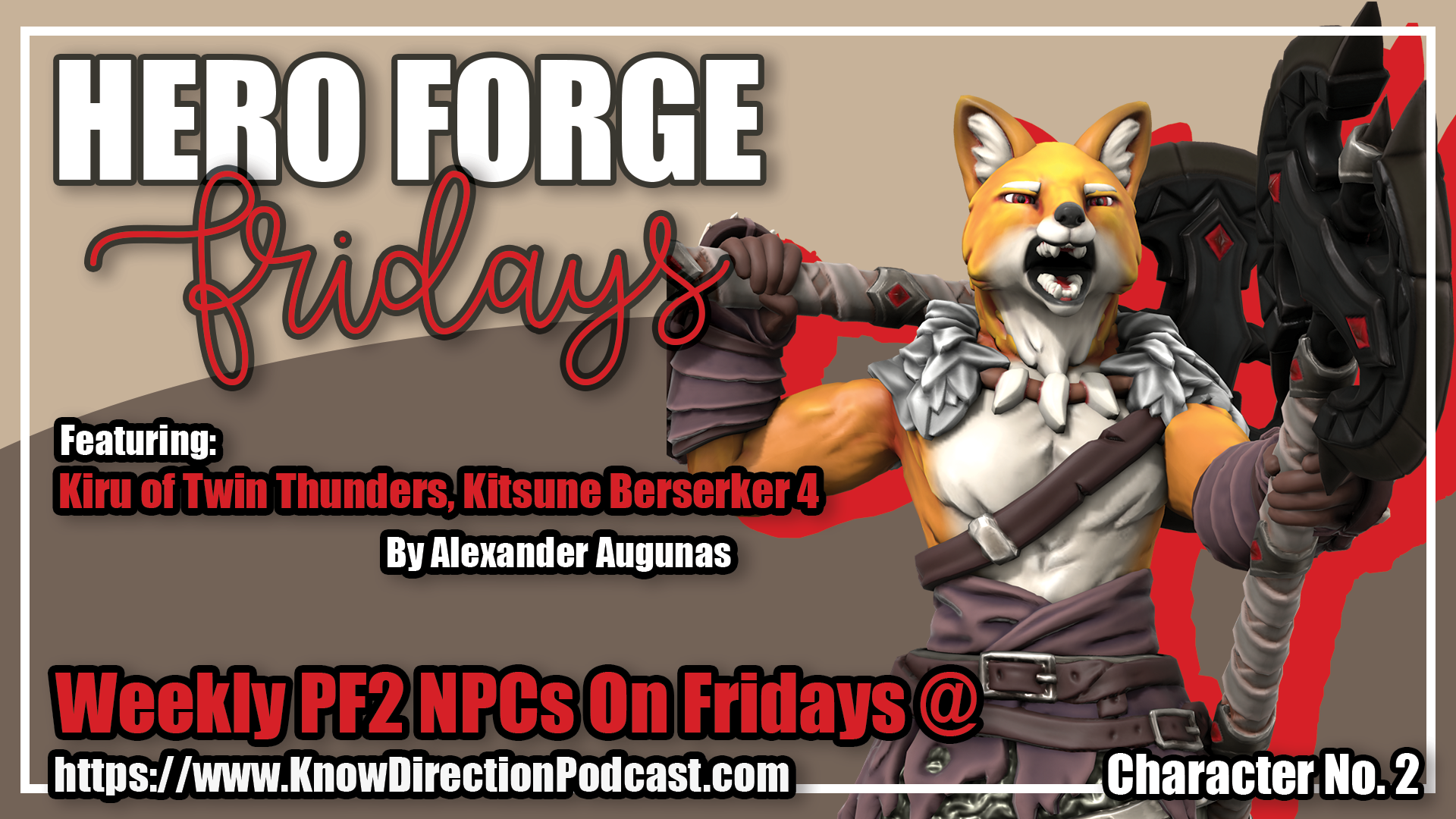Welcome to Guidance, Private Sanctuary’s source for tips and techniques for the Pathfinder Roleplaying Game, written by Everyman Gamer Alexander Augunas. Today, we’re going to be looking at a build focused on fighting defensively.
Stacking AC is surprisingly easy in the Pathfinder Roleplaying Game, if you invest HEAVILY into it. Let’s take a look at a skald build that does just that!
Build Concept
This section summarizes the build and its component options.
- Race: So, you have two real choices here for race: human or halfling. You NEED to be a halfling in order to take all of the feats that you’ll need for this build, so if you go human you’re effectively spending your human bonus feat on Racial Heritage: halfling. As much as I like halflings, that might be the better option for the build. This build makes good use of your Charisma and Wisdom scores, and if you want to hit stuff in combat, the halfling’s Strength penalty isn’t going to work out for you. So yeah, I’d go human and pick up Racial Heritage: halfling.
- Fighter (Unarmed Fighter): We’re picking up one level in this archetype for the free combat style feat that it grants us. Its all of the love of the Master of Many Styles without the pesky alignment restrictions!
- Skald: Ultimately, you can choose to go either bard or skald with this build, because you’re really doing all of this for one specific bardic masterpiece. I’m going with skald because A) its got martial weapon proficiency and B) its generally better geared for martial combat than the bard is. I’m not recommending any specific archetype for the skald, so you’re more than welcome to take whatever you’d like in this regard.
- Perform (Dance): We need ranks in Perform (dance) for this build to work. Sadly, this isn’t one of the versatile performances that skalds can take unless you grab a very specific archetype, the demon dancer from Advanced Class Origins. Personally, I don’t think that the demon dancer is going to fit many people’s flavors, so I’m ignoring it for this build. You’re more than able to grab it (and the aforementioned versatile performance) if you want it, however.
All right! With all the pieces in place, let’s get building!
Early Levels (1–7)
- Classes: fighter (unarmed fighter) 1, skald 6
- Feats: Crane Style (Bonus), Racial Heritage: halfling (Bonus), Cautious Fighter (1st), Scribe Scroll (Bonus), Dodge (3rd), Raging Vitality (5th), Lingering Performance (7th)
- Abilities: bardic knowledge, fuse style, inspired rage +2 (+2 Str/Con), rage power (guarded stance, lesser beast totem), raging song, song of marching, song of strength, spell kenning 1/day, uncanny dodge, versatile performance (any 1), well-versed.
- 2nd Level Skald Spells (4): Allegro, Heroism, The Dance of 23 Steps, any 1.
- 1st Level Skald Spells (4): Compel Hostility, Cure Light Wounds, any 2
- Cantrips (6): Any 6.
Before we begin, I wanted to mention a change in philosophy that I’ve had when writing Iconic Designs over the past month or so. You’ve probably noticed that I’ve stopped being as detailed in what spells spontaneous spellcasters should learn. That’s because unless a spell is absolutely vital for the build to work, there’s really no right or wrong answer for what spells you choose to learn. I don’t want to give the wrong impression that EVERY SPELL THAT I SAY YOU SHOULD TAKE IS 100% THE ONLY SPELL YOU CAN TAKE or anything. So yeah, henceforth I’ll be listing the spells that you’re either forced to take (like bloodline spells) or that I think are vital to the build’s success, but otherwise I’ll just be writing, “any x” at the end of every list so you know how many spells you have to customize this build to your liking. Hope that helps you out going forward!
1st Level is a surprisingly important level for this build. You pick up Crane Style and Cautious Fighter, the later of which is a halfling feat. Crane Style modifies the fighting defensively action, reducing the penalty to –2 and increasing the dodge bonus to +4. Cautious Fighter increases the dodge bonus that you get from fighting defensively by +2. So enjoy your +6 bonus to AC at 1st level; it’ll only cost you a –2 penalty on attack rolls. At 1st level, you’re not going to be wearing armor (you’re not proficient with it), so havng a Wisdom bonus might be a pretty good idea. Or you can eschew armor entirely; its completely up to you. If you budget yourself for a Wisdom of 14 or so for a +2 dodge bonus, you’ll likely be looking at an AC of 18 at 1st level while you’re in Crane Style and fighting defensively, which is pretty awesome. If you choose to grab armor instead starting at 2nd level, that might not be a bad idea either. Ultimately, you’re going to want to either bump up your Dexterity or your Wisdom here, and which one you do is entirely up to you. If you go Dex, I would grab light or medium armor at 2nd level. If you go Wisdom, you might want to avoid the armor. Considering that our primary class, the skald, has good Fortitude and Will saves, going Dexterity might be a good idea in order to bump up that Reflex save a little bit, but having a better Wisdom to avoid Will saves and to spice up your Stunning Fist feat isn’t a terrible idea either. Pick whichever one works best for you.
After our 1st-level dip, its time to completely devote the character to the skald class. I chose skald for several reasons, the biggest of which turns on during the mid levels. At the low levels, the skald’s song gives us a great means to bump up our character’s attack rolls and damage rolls; inspired rage. That +2 Strength is helpful all-around, but in truth I really like some of the more defensively-focused barbarian rage powers that this build grabs. Guarded Stance, for instance, allows the skald to spend a move action to gain a dodge bonus to AC for a number of rounds equal to his current, rage-modified Constitution modifier. If you build for a 12 in Con, you’ll have at least 2 rounds of dodge bonuses against melee attacks, which is helpful. The bonus starts off as a +1 bonus, but increases by +1 for every 6 barbarian levels (or in this case, skald levels) that the character has, for a maximum of +4. By the end game, we’ll see that bonus, making this a worthwhile investment. I’m also building through the beast totem line with this build. Lesser beast totem is pretty worthless to this character, but the higher-level totems are fantastic; they’re what I have my sights on.
Feat-wise, the build gains some pretty weird, but pretty helpful powers. Dodge is a flat +1 bonus to Armor Class, which is much appreciated. Raging Vitality improves our Constitution modifier by 2 while raging, which means Guarded Stance will last an extra round. I’ve also picked up Lingering Performance for a specific reason: The Dance of 23 Steps. I’m going to ask you to invest rather heavily in Perform (dance) for no other reason than this masterpiece, as skalds can’t take versatile performance: dance without also grabbing a rather dubious archetype that I frankly think is a poor option for the skald. But in my opinion, this masterpiece is worth the investment. Effectively, you can spend rounds of bardic performance to gain an effect identical to Combat Expertise, only using your ranks in Perform (dance) as your base attack bonus. Even better, this masterpiece stacks with Combat Expertise and fighting defensively and thanks to Lingering Performance, one round of performance equates to three rounds of attack roll and AC modifications. Performance cycling is a great option for the skald in all, as his allies don’t become fatigued when his inspiring rage ends. Effectively, you can perform for 1 round, then stop and allow it to linger.
NOTE: As far as I can find, bardic masterpieces aren’t bardic performances, so you can have both a bardic masterpiece and a bardic performance active at the same time. There hasn’t been any official confirmation about this, but nowhere in the bardic masterpiece rules does it say that bardic masterpieces ARE bardic performances, just that they use the same resource pool for their effects. This guide will be written assuming that you can maintain inspired rage and The Dance of 23 Steps at once, at the cost of 2 rounds of performance per round if you so choose.
Weapon-wise, you should be carrying three different weapons after you get martial weapon proficiency from the skald class. You’ll want a tonfa (one-handed), a sansetsukon (two-handed), and a bill (two-handed with reach). All of these weapons have one thing in common: when fighting defensively, all of them give you a +1 shield bonus to your AC. At low levels, you can safely ignore the tonfa. In the mid levels, you’ll want it for how it combines with Crane Wing and Crane Riposte.
Your spells don’t matter too much to the build, so you should mostly focus on spells that you like. I recommend having at least one healing spell somewhere in the build, and without a doubt compel hostility and heroism are essentials. Compel hostility is essentially your taunt; you can force your enemies into attacking you with it. Save it for enemies with poor Will saves. I also like heroism because its bonuses (morale to attack and damage) stack with your inspired rage, which isn’t true for the bard’s inspire courage.
So with all that in mind, let’s move onward to the mid levels!
Mid Levels (8 –14)
- Classes: fighter (unarmed fighter) 1, skald 13
- Feats: Crane Style (Bonus), Racial Heritage: halfling (Bonus), Cautious Fighter (1st), Scribe Scroll (Bonus), Dodge (3rd), Raging Vitality (5th), Lingering Performance (7th), Crane Wing (9th), Uncanny Defense (11th), Crane Riposte (13th)
- Abilities: bardic knowledge, dirge of doom, fuse style, DR 1/–, improved uncanny dodge, inspired rage +4 (+4 Str/Con), lore master 2/day, rage power (beast totem, greater beast totem, guarded stance, lesser beast totem), raging song, song of marching, song of strength, spell kenning 2/day, uncanny dodge, versatile performance (any 3), well-versed.
- 5th Level Skald Spells (2): Greater Heroism, any 1
- 4th Level Skald Spells (4): Any 4
- 3rd Level Skald Spells (5): Exquisite Accompaniment, any 4
- 2nd Level Skald Spells (5): Allegro, Heroism, The Dance of 23 Steps, any 2.
- 1st Level Skald Spells (6): Compel Hostility, Cure Light Wounds, any 4
- Cantrips (6): Any 6.
This build gets a LOT of neat tricks in the mid-levels. First up is Uncanny Defense, an awesome halfling feat. Uncanny Defense allows our character to add half of his or her fighting defensively bonus to her Reflex saves and to her CMD. Remember how we once said that Reflex is a weakness for this character? Since fighting defensively is going to give us a total bonus of +3 (+4 because of Crane Style, +2 more from Cautious Fighter, reduced by half). Not bad at all! Later in the level, we finally have the BAB to begin picking up more of the Crane Style feat change. Crane Wing, after the errata, will allow us to pick one opponent and gain a +2 dodge bonus to AC against him as long as we have at least one empty hand. This is why I suggested carrying a tonfa; its essentially your defense weapon. If you REALLY need an extra 2 AC from Crane Wing, put away your awesome two-handed weapon and just use the tonfa one-handed instead. At the very end of the mid levels, we get Crane Riposte, which reduces the fighting defensively penalty further from –2 to –1. This is very helpful for this penalty-heavy build.
Spell-wise, exotic accompaniment is a must. Its awesome that your shadowy instrument can essentially perform your raging song for you without costing you rounds of rage. Gotta love it. Ability wise, we also grab the beast totem, which gives our character a natural armor bonus when he rages. Awesome! Guarded Stance is also going to improve to a total of +3 in this stage of the game. But of course, no one would let me live it down if I didn’t mention that in addition to becoming a defensive juggernaut, your rage also gives all of your allies pounce. Enjoy!
Let’s see where this wacky build ultimately takes us in the end game.
Endgame (15+)
- Classes: fighter (unarmed fighter) 1, skald 19
- Feats: Crane Style (Bonus), Racial Heritage: halfling (Bonus), Cautious Fighter (1st), Scribe Scroll (Bonus), Dodge (3rd), Raging Vitality (5th), Lingering Performance (7th), Crane Wing (9th), Uncanny Defense (11th), Crane Riposte (13th), Osyluth Guile (15th), Combat Expertise (17th), FREE FEAT (19th)
- Abilities: bardic knowledge, dirge of doom, fuse style, DR 3/–, improved uncanny dodge, inspired rage +5 (+6 Str/Con), lore master 3/day, rage power (beast totem, greater beast totem, guarded stance, lesser beast totem, any 2), raging song, song of the fallen, song of marching, song of strength, spell kenning 3/day, uncanny dodge, versatile performance (any 4), well-versed.
- 6th-Level Skald Spells (4): Any 4.
- 5th Level Skald Spells (5): Greater Heroism, any 4.
- 4th Level Skald Spells (5): Any 5.
- 3rd Level Skald Spells (6): Exquisite Accompaniment, any 5.
- 2nd Level Skald Spells (6): Allegro, Heroism, The Dance of 23 Steps, any 3.
- 1st Level Skald Spells (6): Compel Hostility, Cure Light Wounds, any 4
- Cantrips (6): Any 6.
This build basically ends at 15th or 17th level; 17th if you’re allowed to take Osyluth’s Guile, 15th if you’re not. Essentially, this high-level (requires 8 ranks in Bluff) feat allows you to add your Charisma bonus to your AC as a dodge bonus against one target whenever you fight defensively. This old feat is from Cheliax: Empire of Devils which came out right at the cusp of the Pathfinder Roleplaying Game, so I doubt that you’ll actually see it in print anywhere. (Luckily, you can still pick up the PDF!). The other feat you’ll probably want, that we’ve waited all the way until now to take, is Combat Expertise.
Other than those feats, there really isn’t anything that you NEED for this build. You literally have every single ability in the game that grants an AC bonus and stacks with fighting defensively. Let’s review:
Early Game (7th Level)
- Fighting Defensively: +6 (Crane Style + Cautious Fighter +1 shield from blocking weapon)
- Dodge: +5 (Dodge + Guarded Stance +2 + The Dance of 23 Steps +2)
- Attack Penalty: –4 (–2 from Crane Style, –2 from Dance of 23 Steps)
Assuming that you do this, you’re looking at an AC of 10 + 6 (armor) + 7 (fighting defensively) + 5 (dodge bonuses), for a total of 28 at 7th level.
Mid Game (14th Level)
- Fighting Defensively: +6 (Crane Style + Cautious Fighter + 1 shield from blocking weapon)
- Dodge: +10 (Dodge + Guarded Stance +3 + the Dance of 23 Steps +4 + Crane Wing +2)
- Armor: +7 plus Dex, up to +4 (+3 mithral breastplate)
- Natural Armor: +4 (beast totem +4)
- Total AC: 29 plus Dex.
- Attack Penalty: –6 (–2 from Crane Style, –4 from Dance of 23 Steps)
End Game (20th Level)
- Fighting Defensively: +6 (Crane Style + Cautious Fighter + 1 shield from blocking weapon, plus Charisma if Osyluth’s Guile is allowed)
- Dodge: +17 (Dodge + Guarded Stance +4 + The Dance of 23 Steps +5 + Crane Wing +2 + Combat Expertise +5)
- Armor: +11 plus Dex, up to +4 (+5 mithral breastplate)
- Natural Armor: +5 (beast totem +5)
- Total AC: 49 plus Dex and Cha
- Attack Penalty: –11 (–1 from Crane Riposte, –5 from Dance of 23 Steps, –5 from Combat Expertise)
As you can see, the penalties for “full defense mode” start out relatively small, but ramp up quickly into some serious negatives. As what is essentially a medium base attack bonus class, those penalties hurt. You’re almost always going to miss with all of your iterative attacks, and even your first attack is likely to miss. As a result, this build is all about picking which defenses to use and for what reason. You don’t want to turn on all of your AC bonuses all the time. You probably aren’t going to need an AC of 50 most of the time; even if you dropped Combat Expertise, you’d end up with an AC of 45 plus Dex and Cha if Osyluth’s Guile is allowed in your game, and that’s not including any non-armor magic items that you invest into improving your AC, such as a ring of protection (+1 to +5) or an amulet of natural armor (+1 to +5, and which stacks with your beast totem’s natural armor because the amulet provides an enhancement bonus to natural armor). It is very feasible to get your AC into the 60s with this build as a result. This is the major reason that I left Combat Expertise until the end; you can decide for yourself if it is a feat that you actually need.
For reference, the tarrasque’s highest attack bonus is +37, so if you can get an AC of 56, the tarrasque needs a natural 20 to hit you. Cthulhu’s attack bonus is a +42, so if you can get your AC to a 61 then it needs a natural 20 to hit you, and that’s before you even start looking at things like Mythic Dodge. Crazy, right?
And that’s all I’ve got to say about my crazy Tanking Skald. What do you think? Is an emphasis on defense something that you think is ‘worth it’ in your campaign? Personally, its ‘worth it’ in my games, but that’s mostly because I use my psychology rules from Psychological Combat in my campaign. A character playing this build could just antagonize the big, bad guy and get him to attack him. Is this a build that you would consider using? I was actually thinking about whether or not I’d try something like this in PFS, just because optimizing AC is sort of hilarious. Leave your questions and comments below, and I’ll be back next Monday with another article. Take care!
Alexander “Alex” Augunas has been playing roleplaying games since 2007, which isn’t nearly as long as 90% of his colleagues. Alexander is an active freelancer for the Pathfinder Roleplaying Game and is best known as the author of the Pact Magic Unbound series by Radiance House. Alex is the owner of Everyman Gaming, LLC and is often stylized as the Everyman Gamer in honor of Guidance’s original home. Alex’s favorite color is blue, his favorite Pathfinder Race/Class combination is mafling skald. And yes “mafling is half man, half halfling.” Is that a quarterling? Hrm….
Edit (2/20/15): One of my readers, Tyler Buckley, noted that the martial artist and master of many styles archetypes for the monk actually don’t stack. I missed this because the fact that the martial artist replaces “perfect self” is hidden halfway through the middle of the archetype rather than at the end. Nice catch, Tyler! I’ve updated the build so it gains the same effect by taking one level from fighter (unarmed fighter) instead.






Bard’s Inspire Courage adds a competence bonus to attack and damage, and a morale bonus on saves vs charm and fear.
Also, don’t forget the Rod of Balance. When used, the Rod of Balance increases the dodge bonus from fighting defensively by +2… also it lets you jump twice as high/far. You could probably get away with it doubling as a quarterstaff (that’s how I use it in Legacy of Fire).
Threatening Defender might be a good trait to recommend, because it reduces the Combat Expertise ability by 1.
If you opt to build as Halfling, this build goes very well with Risky Striker. You take an AC penalty, but, unlike most, you’ve got the AC to spare.
In all truth, the rod is really a replacement for Crane Style. Note that it doesn’t say that it grants you a +2 bonus, it says it increases your normally +2 bonus to +4. This means that it won’t stack with Crane Style’s increase.
Dodge bonuses always stack and Crane Style says to increase the dodge bonus gained from fighting defensively by +1.
“While using this style and fighting defensively or using the total defense action, you gain an additional +1 dodge bonus to your Armor Class.”
So while the Rod of Balance says that instead of +2, gain +4, Crane Style says increase the dodge bonus by +1, so now it’s a +5, and with Cautious Fighter, you’re getting a +7 dodge bonus. Unfortunately, Rod of Balance is 15k, so you’re unlikely to see it until 10th level at the earliest.